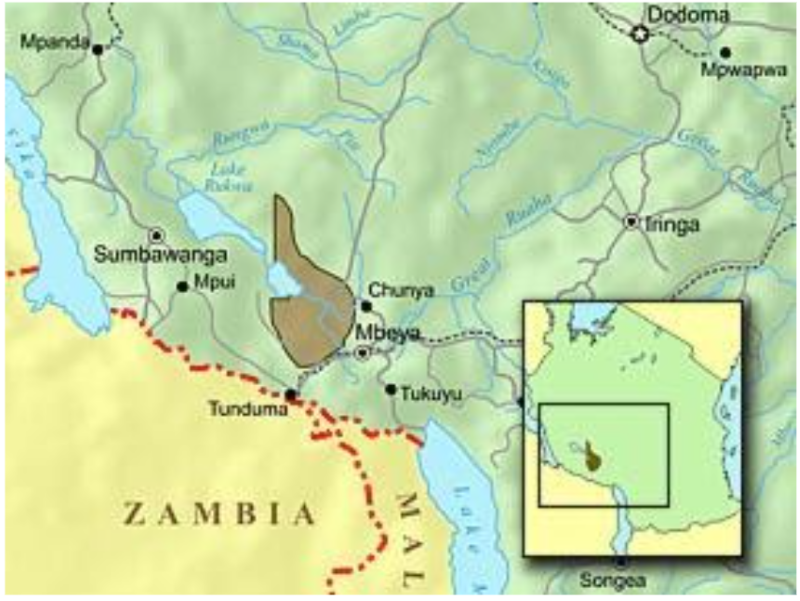
Population: 36,000
Location: Chunya District, Mbeya Region
Diet: Rice, maize, millet, cassava
Religion: Traditional, Christian
Alternate names: Wungu, Echiungu, Kibungu
The Bungu: The heat was intense in the small, half-roofed church. You could barely even see the mud floor, there were so many people packed inside. The atmosphere was charged as a group of young people danced, singing praises in typical Bungu styles. The crowd’s excitment was contagious and nearly the whole service was spent in singing praises except at the end when the prayer items were presented. The power of God was moving as they sang the choruses.
God does not care about economic status, the size of a people group or the level of a person’s education. The Bungu are loved by God, even though they are a small people group who are very poor and have little education. The Roman Catholic Church has quite a strong presence in the region, having been around for almost a century. Nearly all Bungu would claim to be Catholic although they continue to practice their traditional religion.
The Bungu people are nearly unreached with the saving Gospel of Jesus Christ. Before they joined the Mbeya Cluster Project there was nothing written in their language. The evangelical church presence is small but church leaders in the Bungu area really want the Bible to be translated into their language and will be greatly empowered by getting the Bungu Scriptures. The language workers love Jesus and are committed to Bible translation but they face many obstacles and challenges.
Geography and Climate: Semiarid. The Bungu live on the eastern end of Lake Rukwa among the hills, plains, and ridge-like escarpments of the Rift Valley. It is reported that the lake is expanding in size and becoming more shallow, due to erosion. In the dry season the Bungu area can be reached by car from Mbeya in 2-3 hours. During the rainy season the roads may be impassable.
Economic Status: The Bungu are not very wealthy and have little education. They live on farming and fishing. The infrastructure of the area is rather poor. There is one Catholic hospital, one secondary school and a small petrol station in the largest village of the Bungu area. There are gold mines in the area, which have brought in people from various other language groups.
Cultural Information: The Bungu mainly live in mud homes with grass roofs. Many of the Bungu are trap fishermen while others farm or raise cows, pigs, goats or chickens. The main cash crop is cotton in the plains and in the mountainous areas one can find tobacco. The foods they grow are rice, corn/maize, millet and cassava. Millet is used for food and also to make the local beer that people often drink in the afternoons.
Language Group Information: A sociolinguistic survey among the Bungu people was conducted by the Language Assessment team in 1997. The conclusions: Bungu is a vital and viable Bantu language, which is used in most aspects of daily life. The bilingualism with Swahili is quite high, but in the rural areas not sufficient to understand complex concepts. No previous language development has been attempted.
The Bungu believe in a creator God and sacrifices on Mt. Kwimba are very important. The Roman Catholic church has a strong presence in the area and has been around for about a century. Nearly all Bungu would claim to be Catholic although many continue to practice their traditional religion.
A chief explained the Bungu religion in this way: “There are similarities between the traditional religion and Roman Catholic Christianity. The Bungu pray to their ancestors like the Catholics pray to the saints. The old religion has also a sort of trinity, a creator God, his son and the force of God. The only difference is that this son did not come to earth. Discipline is through witchcraft, that is, people obey, when they fear they may be disciplined by witchcraft.”
There are a few Lutheran and Moravian churches. In recent years the Tanzanian Assemblies of God entered the Bungu area, but this church is still very small. The Moravians started work in the area in 1977 and have three small churches. Although almost everyone belongs to the Catholic Church, traditional religion is still practiced by a large portion of the people. Many Bungu people are unreached with the saving Gospel of Jesus Christ.
The Bungu Church: The leadership of the churches working in the Bungu area want to have the Scriptures translated. They recognize that many Bungu do not speak Swahili well enough to understand the Bible. The church leaders say that a translation project will help to open up the area for Christ. History: The Roman Catholic church has a strong presence in the area and has been around for about a century. Nearly all Bungu would claim to be Catholic although they continue to practice their traditional religion.
The Bungu Team: Oscar K. is from the Tanzania Assemblies of God and is a translator. The language committee has people from the Tanzanian Assemblies of God, FPCT, Anglican, Catholic, Lutheran, Tanzania House of Prayer, EAGT and the Moravian Church.
